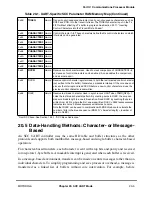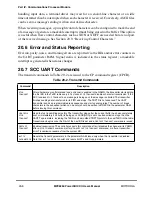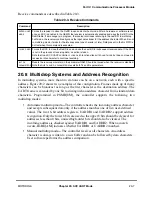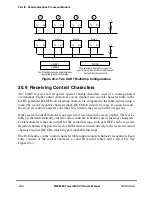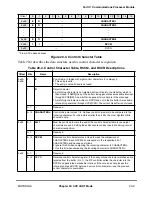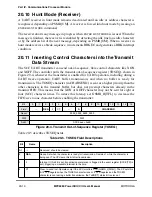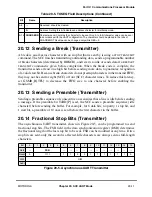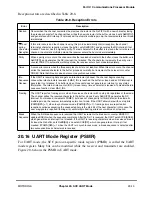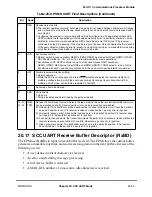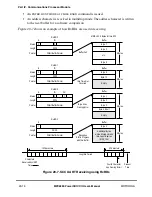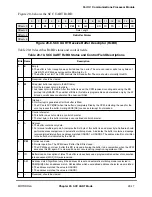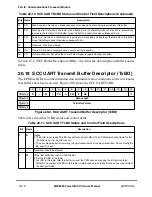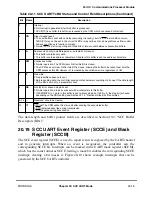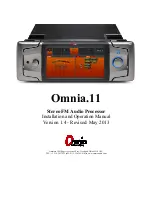
MOTOROLA
Chapter 20. SCC UART Mode
20-19
Part IV. Communications Processor Module
The data length and buffer pointer Þelds are described in Section 19.2, ÒSCC Buffer
Descriptors (BDs).Ó
20.19 SCC UART Event Register (SCCE) and Mask
Register (SCCM)
The SCC event register (SCCE) is used to report events recognized by the UART channel
and to generate interrupts. When an event is recognized, the controller sets the
corresponding SCCE bit. Interrupts can be masked in the UART mask register (SCCM),
which has the same format as SCCE. Setting a mask bit enables the corresponding SCCE
interrupt; clearing a bit masks it. Figure 20-10 shows example interrupts that can be
generated by the SCC UART controller.
3
I
Interrupt.
0 No interrupt is generated after this buffer is processed.
1 SCCE[TX] is set after this buffer is processed by the CPM, which can cause an interrupt.
4
CR
Clear-to-send report.
0 The next buffer is sent with no delay (assuming it is ready), but if a CTS lost condition occurs,
TxBD[CT] may not be set in the correct TxBD or may not be set at all. Asynchronous ßow control,
however, continues to function normally.
1 Normal CTS lost error reporting and three bits of idle are sent between consecutive buffers.
5
A
Address. Valid only in multidrop modeÑautomatic or manual.
0 This buffer contains only data.
1 This buffer contains address characters. All data in this buffer is sent as address characters.
6
CM
Continuous mode.
0 Normal operation. The CPM clears R after this BD is closed.
1 The CPM does not clear R after this BD is closed, allowing the buffer to be resent next time the
CPM accesses this BD. However, R is cleared by transmission errors, regardless of CM.
7
P
Preamble.
0 No preamble sequence is sent.
1 Before sending data, the controller sends an idle character consisting of all ones. If the data length
of this BD is zero, only a preamble is sent.
8
NS
No stop bit or shaved stop bit sent.
0 Normal operation. Stop bits are sent with all characters in this buffer.
1 If PSMR[SYN] = 1, data in this buffer is sent without stop bits. If SYN = 0, the stop bit is shaved,
depending on the DSR setting; see Section 20.14, ÒFractional Stop Bits (Transmitter).Ó
9Ð14 Ñ
Reserved, should be cleared.
15
CT
CTS lost. The CPM writes this status bit after sending the associated buffer.
0 CTS remained asserted during transmission.
1 CTS negated during transmission.
Table 20-11. SCC UART TxBD Status and Control Field Descriptions (Continued)
Bit
Name
Description
Summary of Contents for MPC8260 PowerQUICC II
Page 1: ...MPC8260UM D 4 1999 Rev 0 MPC8260 PowerQUICC II UserÕs Manual ª ª ...
Page 66: ...lxvi MPC8260 PowerQUICC II UserÕs Manual MOTOROLA ...
Page 88: ...1 18 MPC8260 PowerQUICC II UserÕs Manual MOTOROLA Part I Overview ...
Page 120: ...2 32 MPC8260 PowerQUICC II UserÕs Manual MOTOROLA Part I Overview ...
Page 138: ...Part II iv MPC8260 PowerQUICC II UserÕs Manual MOTOROLA Part II Configuration and Reset ...
Page 184: ...4 46 MPC8260 PowerQUICC II UserÕs Manual MOTOROLA Part II ConÞguration and Reset ...
Page 202: ...Part III vi MPC8260 PowerQUICC II UserÕs Manual MOTOROLA Part III The Hardware Interface ...
Page 266: ...8 34 MPC8260 PowerQUICC II UserÕs Manual MOTOROLA Part III The Hardware Interface ...
Page 382: ...10 106 MPC8260 PowerQUICC II UserÕs Manual MOTOROLA Part III The Hardware Interface ...
Page 392: ...11 10 MPC8260 PowerQUICC II UserÕs Manual MOTOROLA Part III The Hardware Interface ...
Page 430: ...Part IV viii MOTOROLA Part IV Communications Processor Module ...
Page 490: ...14 36 MPC8260 PowerQUICC II UserÕs Manual MOTOROLA Part IV Communications Processor Module ...
Page 524: ...17 10 MPC8260 PowerQUICC II UserÕs Manual MOTOROLA Part IV Communications Processor Module ...
Page 556: ...18 32 MPC8260 PowerQUICC II UserÕs Manual MOTOROLA Part IV Communications Processor Module ...
Page 584: ...19 28 MPC8260 PowerQUICC II UserÕs Manual MOTOROLA Part IV Communications Processor Module ...
Page 632: ...21 24 MPC8260 PowerQUICC II UserÕs Manual MOTOROLA Part IV Communications Processor Module ...
Page 652: ...22 20 MPC8260 PowerQUICC II UserÕs Manual MOTOROLA Part IV Communications Processor Module ...
Page 668: ...23 16 MPC8260 PowerQUICC II UserÕs Manual MOTOROLA Part IV Communications Processor Module ...
Page 758: ...27 28 MPC8260 PowerQUICC II UserÕs Manual MOTOROLA Part IV Communications Processor Module ...
Page 780: ...28 22 MPC8260 PowerQUICC II UserÕs Manual MOTOROLA Part IV Communications Processor Module ...
Page 874: ...29 94 MPC8260 PowerQUICC II UserÕs Manual MOTOROLA Part IV Communications Processor Module ...
Page 920: ...31 18 MPC8260 PowerQUICC II UserÕs Manual MOTOROLA Part IV Communications Processor Module ...
Page 980: ...A 4 MPC8260 PowerQUICC II UserÕs Manual MOTOROLA Appendixes ...
Page 1002: ...Index 22 MPC8260 PowerQUICC II UserÕs Manual MOTOROLA INDEX ...
Page 1006: ......

